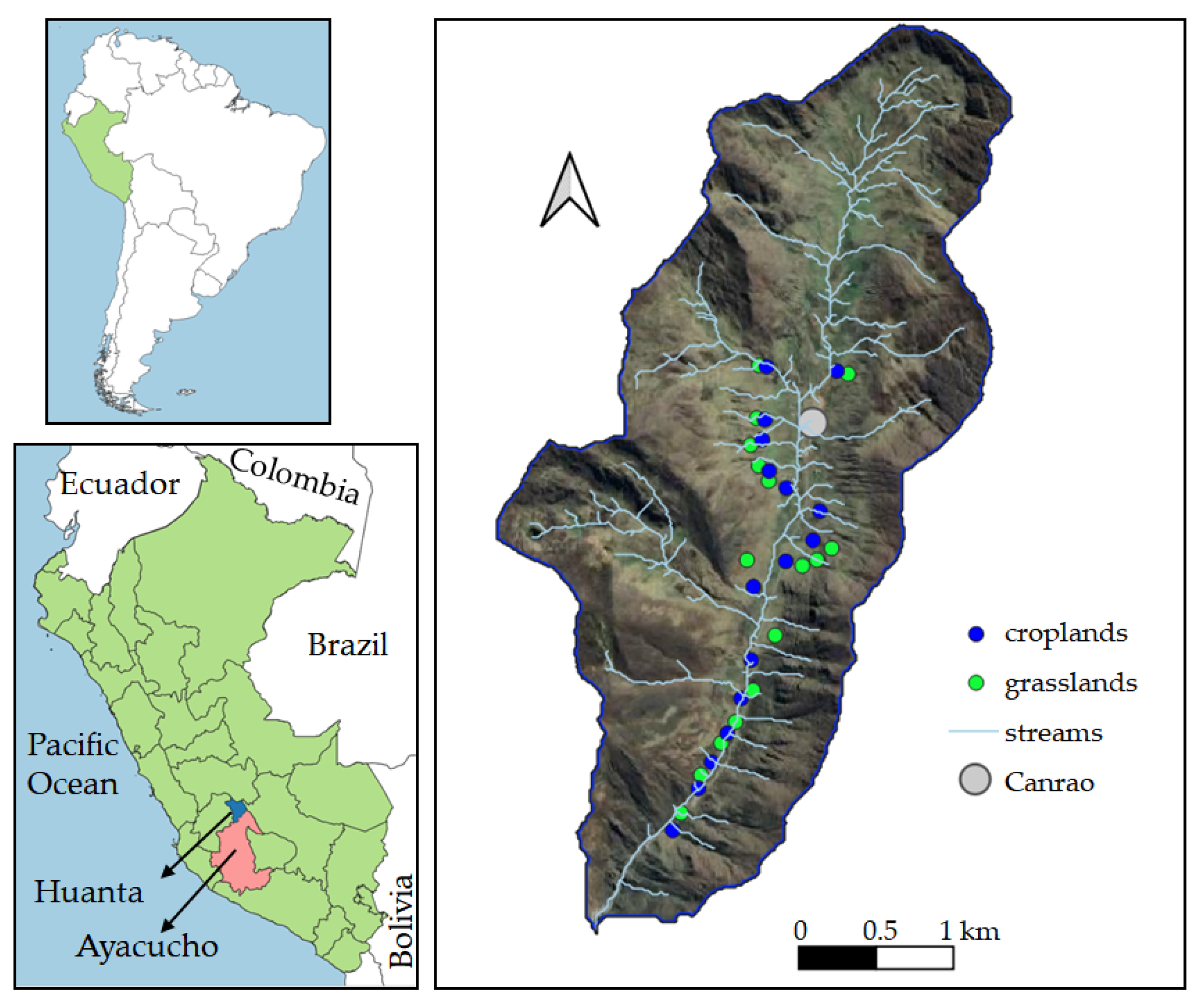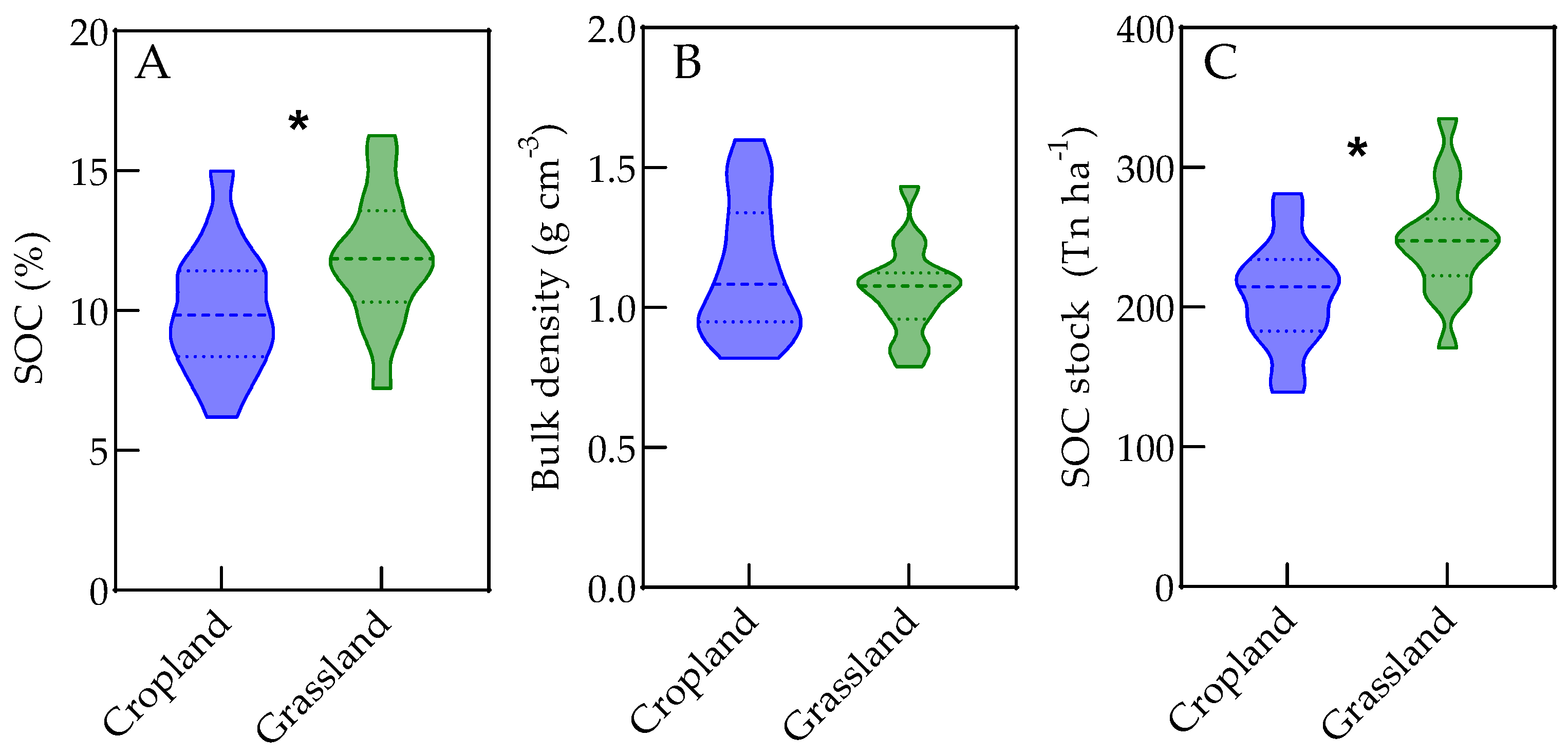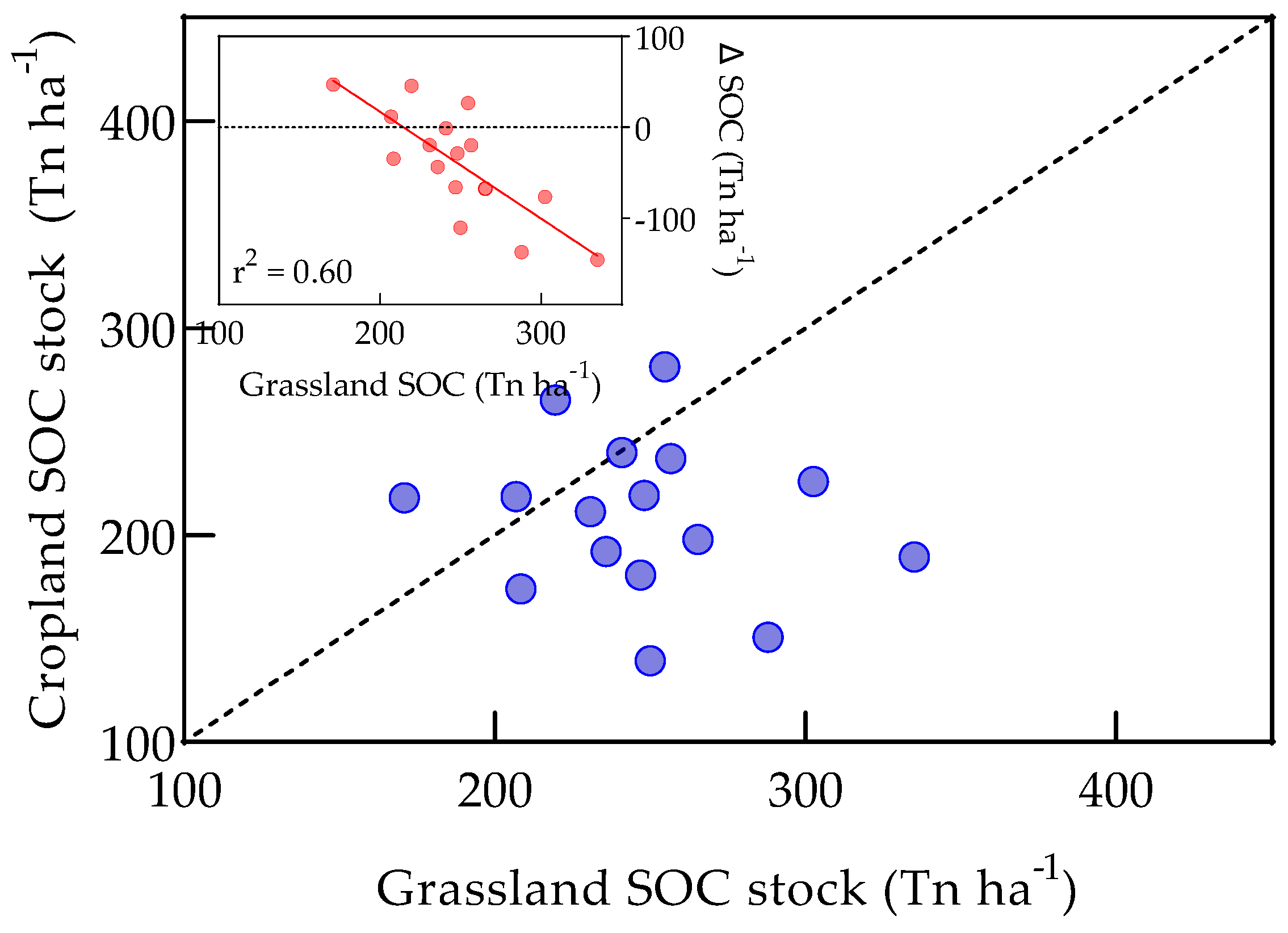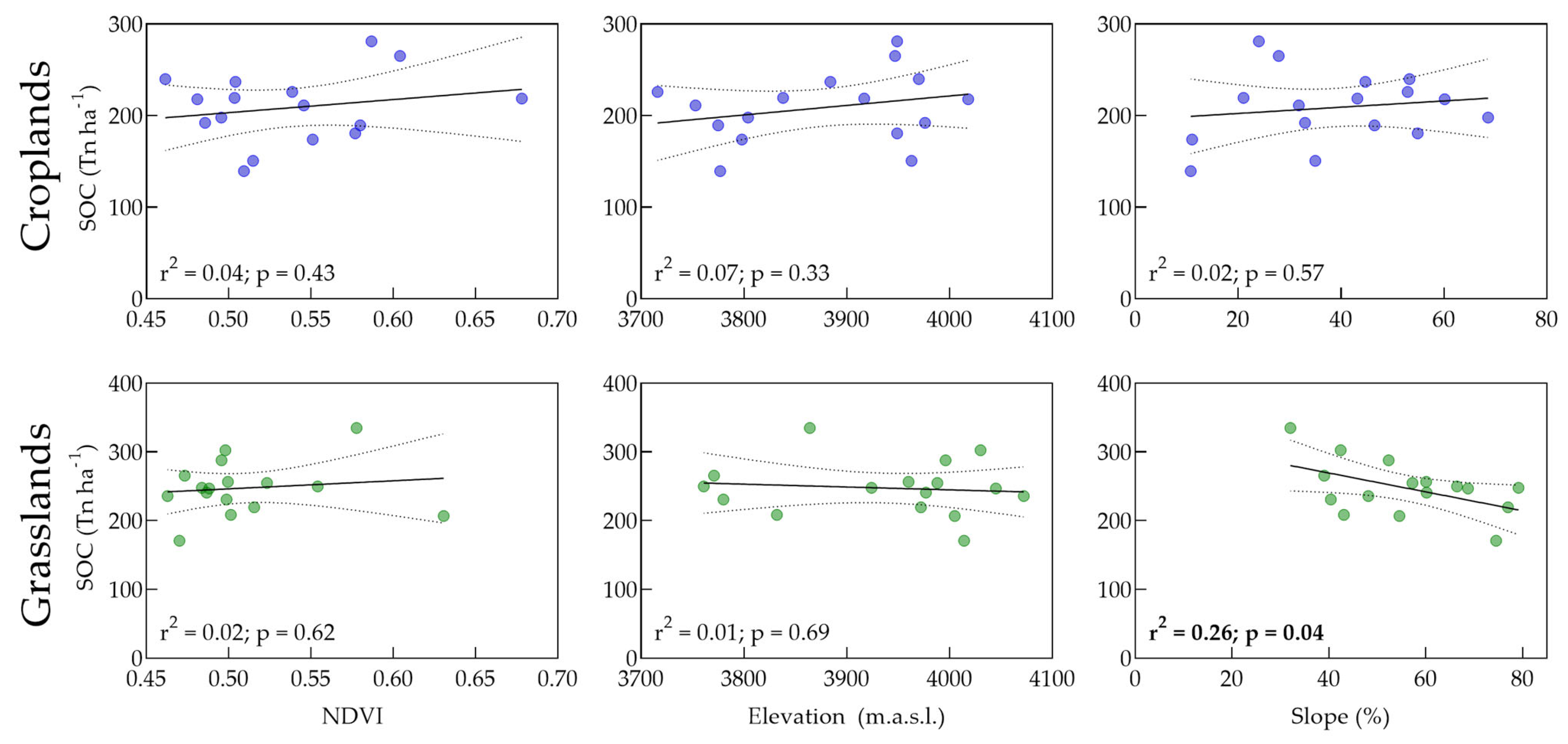Changes in the Soil Organic Carbon of Grasslands in the High Andes of Peru after Their Conversion to Croplands and Their Environmental Controls
Abstract
1. Introduction
2. Materials and Methods
2.1. Study Area
2.2. Soil Sampling and Analysis
3. Results and Discussion
4. Conclusions
Author Contributions
Funding
Institutional Review Board Statement
Informed Consent Statement
Data Availability Statement
Acknowledgments
Conflicts of Interest
References
- Marín, M.A.M.; Pescador, L.R.; Ramos, L.R.; Charry, J.L.A. Impacto de la actividad ganadera sobre el suelo en Colombia. Ing. Y Región 2017, 17, 1–12. [Google Scholar] [CrossRef]
- Brooks, T.M.; Mittermeier, R.A.; da Fonseca, G.A.B.; Gerlach, J.; Hoffmann, M.; Lamoreux, J.F.; Mittermeier, C.G.; Pilgrim, J.D.; Rodrigues, A.S.L. Global Biodiversity Conservation Priorities. Science 2006, 313, 58–61. [Google Scholar] [CrossRef] [PubMed]
- Murillo-Sandoval, P.J.; Clerici, N.; Correa-Ayram, C. Rapid loss in landscape connectivity after the peace agreement in the Andes-Amazon region. Glob. Ecol. Conserv. 2022, 38, e02205. [Google Scholar] [CrossRef]
- Paruelo, J.M.; Guerschman, J.P.; Verón, S.R. Expansión agrícola y cambios en el uso del suelo. Cienc. Hoy 2005, 15, 14–23. [Google Scholar]
- Birkhofer, K.; Diehl, E.; Andersson, J.; Ekroos, J.; Früh-Müller, A.; Machnikowski, F.; Mader, V.L.; Nilsson, L.; Sasaki, K.; Rundlöf, M. Ecosystem services—Current challenges and opportunities for ecological research. Front. Ecol. Evol. 2015, 2, 87. [Google Scholar] [CrossRef]
- Arizapana-Almonacid, M.A.; Pariona-Antonio, V.H.; Castañeda-Tinco, I.; Ascención Mendoza, J.C.; Gutiérrez Gómez, E.; Ramoni-Perazzi, P. Land cover changes and comparison of current landscape metrics in a region of the Central Andes affected by population migration. Ann. GIS 2024, 1–16. [Google Scholar] [CrossRef]
- Evrendilek, F.; Celik, I.; Kilic, S. Changes in soil organic carbon and other physical soil properties along adjacent Mediterranean forest, grassland, and cropland ecosystems in Turkey. J. Arid Environ. 2004, 59, 743–752. [Google Scholar] [CrossRef]
- Powlson, D.S.; Gregory, P.J.; Whalley, W.R.; Quinton, J.N.; Hopkins, D.W.; Whitmore, A.P.; Hirsch, P.R.; Goulding, K.W.T. Soil management in relation to sustainable agriculture and ecosystem services. Food Policy 2011, 36, S72–S87. [Google Scholar] [CrossRef]
- Sylvester, S.P.; Heitkamp, F.; Sylvester, M.D.; Jungkunst, H.F.; Sipman, H.J.; Toivonen, J.M.; Gonzales Inca, C.A.; Ospina, J.C.; Kessler, M. Relict high-Andean ecosystems challenge our concepts of naturalness and human impact. Sci. Rep. 2017, 7, 3334. [Google Scholar] [CrossRef]
- Janzen, H.H. Carbon cycling in earth systems—A soil science perspective. Agric. Ecosyst. Environ. 2004, 104, 399–417. [Google Scholar] [CrossRef]
- Teague, R.; Kreuter, U. Managing grazing to restore soil health, ecosystem function, and ecosystem services. Front. Sustain. Food Syst. 2020, 4, 157. [Google Scholar] [CrossRef]
- Lal, R. Soil carbon sequestration to mitigate climate change. Geoderma 2004, 123, 1–22. [Google Scholar] [CrossRef]
- Doetterl, S.; Berhe, A.A.; Nadeu, E.; Wang, Z.; Sommer, M.; Fiener, P. Erosion, deposition and soil carbon: A review of process-level controls, experimental tools and models to address C cycling in dynamic landscapes. Earth-Sci. Rev. 2016, 154, 102–122. [Google Scholar] [CrossRef]
- Homann, P.S.; Kapchinske, J.S.; Boyce, A. Relations of mineral-soil C and N to climate and texture: Regional differences within the conterminous USA. Biogeochemistry 2007, 85, 303–316. [Google Scholar] [CrossRef]
- Jobbágy, E.G.; Jackson, R.B. The vertical distribution of soil organic carbon and its relation to climate and vegetation. Ecol. Appl. 2000, 10, 397–398. [Google Scholar] [CrossRef]
- Wiesmeier, M.; Urbanski, L.; Hobley, E.; Lang, B.; von Lützow, M.; Marin-Spiotta, E.; van Wesemael, B.; Rabot, E.; Ließ, M.; Garcia-Franco, N.; et al. Soil organic carbon storage as a key function of soils—A review of drivers and indicators at various scales. Geoderma 2019, 333, 149–162. [Google Scholar] [CrossRef]
- Houspanossian, J.; Nosetto, M.; Jobbágy, E.G. Radiation budget changes with dry forest clearing in temperate Argentina. Glob. Change Biol. 2013, 19, 1211–1222. [Google Scholar] [CrossRef] [PubMed]
- Magliano, P.N.; Gimenez, R.; Houspanossian, J.; Páez, R.; Nosetto, M.D.; Fernández, R.; Jobbágy, E.G. Litter is more effective than forest canopy reducing soil evaporation in Dry Chaco rangelands. Ecohydrology 2017, 10, e1879. [Google Scholar] [CrossRef]
- Zogg, G.P.; Zak, D.R.; Ringelberg, D.B.; White, D.C.; MacDonald, N.W.; Pregitzer, K.S. Compositional and Functional Shifts in Microbial Communities Due to Soil Warming. Soil Sci. Soc. Am. J. 1997, 61, 475–481. [Google Scholar] [CrossRef]
- Steinaker, D.; Wilson, S. Belowground litter contributions to nitrogen cycling at a northern grassland-forest boundary. Ecology 2005, 86, 2825–2833. [Google Scholar] [CrossRef]
- Nosetto, M.D.; Jobbágy, E.G.; Paruelo, J.M. Carbon sequestration in semiarid rangelands: Comparison of Pinus ponderosa plantations and grazing exclusion in NW Patagonia. J. Arid Environ. 2006, 67, 142–156. [Google Scholar] [CrossRef]
- Jobbágy, E.G.; Sala, O.E.; Paruelo, J.M. Patterns and controls of primary production in the patagonian steppe: A remote sensing approach. Ecology 2002, 83, 307–319. [Google Scholar]
- Paruelo, J.M.; Epstein, H.E.; Lauenroth, W.K.; Burke, I.C. ANPP estimates from NDVI for the central grassland region of the United States. Ecology 1997, 78, 953–958. [Google Scholar] [CrossRef]
- Lopresti, M.F.; Di Bella, C.M.; Degioanni, A.J. Relationship between MODIS-NDVI data and wheat yield: A case study in Northern Buenos Aires province, Argentina. Inf. Process. Agric. 2015, 2, 73–84. [Google Scholar] [CrossRef]
- Nagy, A.; Fehér, J.; Tamás, J. Wheat and maize yield forecasting for the Tisza river catchment using MODIS NDVI time series and reported crop statistics. Comput. Electron. Agric. 2018, 151, 41–49. [Google Scholar] [CrossRef]
- Ren, J.; Chen, Z.; Zhou, Q.; Tang, H. Regional yield estimation for winter wheat with MODIS-NDVI data in Shandong, China. Int. J. Appl. Earth Obs. Geoinf. 2008, 10, 403–413. [Google Scholar] [CrossRef]
- Instituto Nacional de Estadistica e Informatica. Directorio Nacional de Centros Poblados Censos Nacionales 2017: XII de Población, VII de Vivienda y III de Comunidades Indígenas. Tomo 2 Ayacucho, Cajamarca Callao y Cusco. 2018. Available online: https://www.inei.gob.pe/media/MenuRecursivo/publicaciones_digitales/Est/Lib1541/tomo2.pdf (accessed on 1 October 2023).
- Municipalidad Distrital de Sivia. Evaluación de Riesgos por Inundaciones Fluvial, en la Localidad de Sivia—Sector río Sivia Mayo, Distrito de Sivia, Provincia de Huanta—Ayacucho; CENEPRED: Ayacucho, Peru, 2019. [Google Scholar]
- Blake, G.; Hartge, K. Bulk density. In Methods of Soil Analysis: Part 1. Physical and Mineralogical Methods; Klute, A., Ed.; Wiley: Madison, WI, USA, 1986; pp. 363–375. [Google Scholar]
- Villarino, S.H.; Studdert, G.A.; Baldassini, P.; Cendoya, M.G.; Ciuffoli, L.; Mastrángelo, M.; Piñeiro, G. Deforestation impacts on soil organic carbon stocks in the Semiarid Chaco Region, Argentina. Sci. Total Environ. 2017, 575, 1056–1065. [Google Scholar] [CrossRef]
- Post, W.M.; Kwon, K.C. Soil carbon sequestration and land-use change: Processes and potential. Glob. Change Biol. 2000, 6, 317–327. [Google Scholar] [CrossRef]
- Chavez, P.S., Jr. Radiometric calibration of Landsat Thematic Mapper multispectral images. Photogramm. Eng. Remote Sens. 1989, 55, 1285–1294. [Google Scholar]
- Wyngaard, N.; Crespo, C.; Angelini, H.; Eyherabide, M.; Larrea, G.; Reussi Calvo, N.; Carciochi, W.; Sainz Rozas, H. The effect of agriculture on topsoil carbon stocks is controlled by land use, climate, and soil properties in the Argentinean Pampas. CATENA 2022, 212, 106126. [Google Scholar] [CrossRef]
- Zhao, W.; Hu, Z.; Li, S.; Guo, Q.; Yang, H.; Zhang, T. Impact of land use conversion on soil organic carbon stocks in an agro-pastoral ecotone of Inner Mongolia. J. Geogr. Sci. 2017, 27, 999–1010. [Google Scholar] [CrossRef]
- Shiferaw, A.; Yimer, F.; Tuffa, S. Changes in soil organic carbon stock under different land use types in semiarid Borana rangelands: Implications for CO2 emission mitigation in the rangelands. J. Agric. Sci. Food Res. 2019, 10, 254. [Google Scholar] [CrossRef]
- Guo, L.B.; Gifford, R.M. Soil carbon stocks and land use change: A meta analysis. Glob. Change Biol. 2002, 8, 345–360. [Google Scholar] [CrossRef]
- Poeplau, C.; Don, A.; Vesterdal, L.; Leifeld, J.; Van Wesemael, B.; Schumacher, J.; Gensior, A. Temporal dynamics of soil organic carbon after land-use change in the temperate zone—Carbon response functions as a model approach. Glob. Change Biol. 2011, 17, 2415–2427. [Google Scholar] [CrossRef]
- Hassink, J.; Whitmore, A.P.; Kubát, J. Size and density fractionation of soil organic matter and the physical capacity of soils to protect organic matter. Eur. J. Agron. 1997, 7, 189–199. [Google Scholar] [CrossRef]
- Balesdent, J.; Chenu, C.; Balabane, M. Relationship of soil organic matter dynamics to physical protection and tillage. Soil Tillage Res. 2000, 53, 215–230. [Google Scholar] [CrossRef]
- Farley, K.A.; Bremer, L.L.; Harden, C.P.; Hartsig, J. Changes in carbon storage under alternative land uses in biodiverse Andean grasslands: Implications for payment for ecosystem services. Conserv. Lett. 2013, 6, 21–27. [Google Scholar] [CrossRef]
- Farley, K.A.; Kelly, E.F.; Hofstede, R.G. Soil organic carbon and water retention after conversion of grasslands to pine plantations in the Ecuadorian Andes. Ecosystems 2004, 7, 729–739. [Google Scholar] [CrossRef]
- Soussana, J.F.; Loiseau, P.; Vuichard, N.; Ceschia, E.; Balesdent, J.; Chevallier, T.; Arrouays, D. Carbon cycling and sequestration opportunities in temperate grasslands. Soil Use Manag. 2004, 20, 219–230. [Google Scholar] [CrossRef]
- Aguilar, S.Y. Validación del Método de Calcinación en la Determinación del Contenido de la Materia Orgánica del Suelo; Universidad Nacional Agraria La Molina: Lima, Peru, 2019. [Google Scholar]
- Ayala, L.; Villa, M.; Mendoza, Z.A.; Mendoza, N.A. Cuantificación del carbono en los páramos del parque nacional Yacuri, provincias de Loja y Zamora Chinchipe, Ecuador. Cedamaz 2014, 4, 45–52. [Google Scholar]
- Yang, S.; Jansen, B.; Kalbitz, K.; Chunga Castro, F.O.; van Hall, R.L.; Cammeraat, E.L. Lithology controlled soil organic carbon stabilization in an alpine grassland of the Peruvian Andes. Environ. Earth Sci. 2020, 79, 66. [Google Scholar] [CrossRef]
- Mamani, R.P. Evaluación del Contenido de Carbono Orgánico del Suelo en la Región Andina de Bolivia; Universidad Mayor de San Andrés: La Paz, Bolivia, 2021. [Google Scholar]
- Montes Pulido, C.R. Cuantificación del Carbono Orgánico en el Suelo Bajo dos Tipos de uso, en el Ecosistema de Páramo de Sumapaz, Cundinamarca, Colombia; Universidad Católica “Santa Teresa de Jesús” de Ávila: Ávila, Spain, 2015. [Google Scholar]
- Tan, Z.X.; Lal, R.; Smeck, N.E.; Calhoun, F.G. Relationships between surface soil organic carbon pool and site variables. Geoderma 2004, 121, 187–195. [Google Scholar] [CrossRef]
- Leifeld, J.; Bassin, S.; Fuhrer, J. Carbon stocks in Swiss agricultural soils predicted by land-use, soil characteristics, and altitude. Agric. Ecosyst. Environ. 2005, 105, 255–266. [Google Scholar] [CrossRef]
- Goward, S.N.; Dye, D.G. Evaluating North American net primary productivity with satellite observations. Adv. Space Res. 1987, 7, 165–174. [Google Scholar] [CrossRef]
- Peri, P.; Gaitán, J.; Mastrangelo, M.; Nosetto, M.D.; Villagra, P.E.; Balducci, E.; Pinazo, M.; Eclesia, R.P.; Von Wallis, A.; Villarino, S.; et al. Soil organic carbon stocks in native forest of Argentina: A useful surrogate for mitigation and conservation planning under climate variability. Ecol. Process. 2024, 13, 1. [Google Scholar] [CrossRef]
- Frasier, I.; Barbero, F.M.; Pérez-Brandan, C.; Gómez, M.F.; Fernández, R.; Quiroga, A.R.; Posse-Beaulieu, G.; Restovich, S.; Meriles, J.; Serri, D.L. Roots are the key for soil C restoration: A comparison of land management in the semiarid Argentinean Pampa. Soil Tillage Res. 2024, 235, 105918. [Google Scholar] [CrossRef]
- Nosetto, M.D.; Jobbágy, E.G.; Brizuela, A.B.; Jackson, R.B. The hydrologic consequences of land cover change in central Argentina. Agric. Ecosyst. Environ. 2012, 154, 2–11. [Google Scholar] [CrossRef]





Disclaimer/Publisher’s Note: The statements, opinions and data contained in all publications are solely those of the individual author(s) and contributor(s) and not of MDPI and/or the editor(s). MDPI and/or the editor(s) disclaim responsibility for any injury to people or property resulting from any ideas, methods, instructions or products referred to in the content. |
© 2024 by the authors. Licensee MDPI, Basel, Switzerland. This article is an open access article distributed under the terms and conditions of the Creative Commons Attribution (CC BY) license (https://creativecommons.org/licenses/by/4.0/).
Share and Cite
Medina Quispe, P.R.; Arizapana-Almonacid, M.A.; Nosetto, M.D. Changes in the Soil Organic Carbon of Grasslands in the High Andes of Peru after Their Conversion to Croplands and Their Environmental Controls. Grasses 2024, 3, 35-44. https://doi.org/10.3390/grasses3010004
Medina Quispe PR, Arizapana-Almonacid MA, Nosetto MD. Changes in the Soil Organic Carbon of Grasslands in the High Andes of Peru after Their Conversion to Croplands and Their Environmental Controls. Grasses. 2024; 3(1):35-44. https://doi.org/10.3390/grasses3010004
Chicago/Turabian StyleMedina Quispe, Paolo Rivaldo, Marco Aurelio Arizapana-Almonacid, and Marcelo Daniel Nosetto. 2024. "Changes in the Soil Organic Carbon of Grasslands in the High Andes of Peru after Their Conversion to Croplands and Their Environmental Controls" Grasses 3, no. 1: 35-44. https://doi.org/10.3390/grasses3010004
APA StyleMedina Quispe, P. R., Arizapana-Almonacid, M. A., & Nosetto, M. D. (2024). Changes in the Soil Organic Carbon of Grasslands in the High Andes of Peru after Their Conversion to Croplands and Their Environmental Controls. Grasses, 3(1), 35-44. https://doi.org/10.3390/grasses3010004





